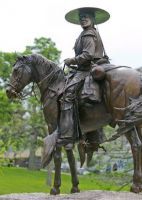UT System Board of Regents approves “Vaqueros” as athletic nickname for new university
UTRGV President Guy Bailey recommended the nickname and colors to the board’s Academic Affairs committee on Wednesday after months of soliciting input from thousands of stakeholders.
Bailey said he chose the Vaqueros because he wanted to recommend something authentic to the Rio Grande Valley that represents the spirit of South Texas.
While the selection drew support from many, including the mayors of Edinburg and Brownsville and the Brownsville Chamber of Commerce, it also spurred a backlash on social media, primarily from those who wanted to keep UT Pan American’s nickname, the Broncs.
“The new mascot will bring together UTB and UTPA students,” said Maria Hall, president and CEO of the Brownsville Chamber of Commerce. “It will also unite alumni as they embrace the legacy of their alma mater and continue supporting UTRGV as the future of our region. Go Vaqueros!”
Regents supported Bailey’s decision and agreed that an original identity, steeped in the legacies of both UT Brownsville and UT Pan American, is imperative for the new university.
“This should be a moment of unity,” said Regents Vice Chairman Gene Powell, who also serves as the board’s special liaison to South Texas. “After months of discussion and opportunity for input, no clear consensus emerged. I applaud Dr. Bailey for looking across the spectrum and making a recommendation that is representative of the history and culture of the Valley. The mission of UTRGV will be world-class education, research and health care. Those are the hallmarks of a great university. It is time now to focus on the important work still ahead of us in those areas.”
The vaqueros were the horsemen and cattle herders who laid the foundation for the North American cowboy and cowboy culture. There is no more iconic figure in American lore than the cowboy and that iconic figure was born in the Rio Grande Valley, Bailey said.
Regent Ernie Aliseda, who is from McAllen, said he is proud to support the Vaquero and believes it is a superb icon to represent UTRGV’s athletic teams, despite some criticism due to the fact that it’s a Spanish word.
“Our own guiding principles for UTRGV promote graduating individuals who are bicultural, bilingual and biliterate. Our university is at the epicenter of the English- and Spanish-speaking Americas,” Aliseda said. “Similar to the Tejano Monument at the State Capitol, I feel the Vaquero represents our history and heritage in South Texas.”
Dedicated in 2012, the granite and bronze Tejano Monument’s life-size statues depict a vaquero on his mustang, two longhorns and a family of settlers.
Next steps for UTRGV include designing logos and the look for the Vaqueros. Also, a team mascot – the character that inspires the crowd from the sidelines – must be chosen. Bailey stressed that students will have a premier role in that process.
About The University of Texas Rio Grande Valley
The University of Texas Rio Grande Valley was created by the Texas Legislature in 2013 in a historic move that will combine the resources and assets of UT Brownsville and UT Pan American and, for the first time, make it possible for residents of the Rio Grande Valley to benefit from the Permanent University Fund. The institution will also be home to a School of Medicine and will transform Texas and the nation by becoming a leader in student success, teaching, research and healthcare. UTRGV will enroll its first class in the fall of 2015, and the School of Medicine will open in 2016.
About The University of Texas System
Educating students, providing care for patients, conducting groundbreaking research and serving the needs of Texans and the nation for more than 130 years, The University of Texas System is one of the largest public university systems in the United States, with nine academic universities, six health institutions and an enrollment of more than 214,000. The UT System confers more than one-third of the state’s undergraduate degrees, educates two-thirds of the state’s health care professionals annually and accounts for almost 70 percent of all research funds awarded to public universities in Texas. The UT System has an annual operating budget of $15.6 billion (FY 2015) including $3 billion in sponsored programs funded by federal, state, local and private sources. With about 90,000 employees, the UT System is one of the largest employers in the state.


